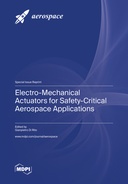Explore

Electro-Mechanical Actuators for Safety-Critical Aerospace Applications
0 Ungluers have
Faved this Work
Login to Fave
Aircraft electrification is one of the most important and strategic initiatives currently supporting the innovation of the aviation industry. This manifests in the well-known more-electric aircraft concept (with the ultimate aim of achieving the all-electric long-term target), which aims to gradually replace onboard systems based on mechanical, hydraulic, or pneumatic power sources with electrically powered ones to reduce the weight and costs, optimize energy, and increase the eco-compatibility and reliability of future aircrafts.A key technological enabler for pursuing these challenging objectives is electro-mechanical actuation. The applicability of electro-mechanical actuators (EMAs) in aerospace has been proved in terms of dynamic performances, but it still entails several concerns in terms of reliability/safety and operation in a harsh environment. In civil aircrafts, EMAs are often avoided for safety-critical functions (flight controls, brakes, landing gears, and nose wheel steering), essentially because the statistical database on the components' fault modes is poor.This Special Issue is thus focused on advancements and innovations in the design, modelling/simulation, architectural definition, reliability/safety analysis, control, condition-monitoring, and experimental testing of EMAs developed for safety-critical aerospace applications. The research papers included in this Special Issue will undoubtedly contribute to progress towards the objective of more electric flights.
This book is included in DOAB.
Why read this book? Have your say.
You must be logged in to comment.
Rights Information
Are you the author or publisher of this work? If so, you can claim it as yours by registering as an Unglue.it rights holder.Downloads
This work has been downloaded 74 times via unglue.it ebook links.
- 74 - pdf (CC BY) at Unglue.it.
Keywords
- active cylindrical coupler
- actuator
- actuator compensation
- actuator faults
- aerospace
- aircraft anti-skid braking system
- all-electric aircraft
- all-electric propulsion
- axial-flux PMSMS
- bending
- coil
- control system
- correction coefficient
- deep reinforcement learning
- dimensional analysis
- dissimilar redundant actuation system
- electric machines
- electrically actuated nose wheel steering
- electro-mechanical actuators
- electromagnetic damper
- Electromagnetic Simulation
- electromechanical
- electromechanical actuators
- experimental validation
- failure transient analysis
- fault diagnosis
- fault-tolerant control
- fault-tolerant systems
- Finite element method
- fixed-wing UAV
- flight analysis
- flight control
- Friction
- full-electric propulsion system
- health monitoring
- helicopter attitude control
- History of engineering & technology
- hybrid UAV
- incremental nonlinear dynamic inversion (INDI)
- inter-turn short circuit
- landing gear shimmy reduction
- linear active-disturbance rejection control
- macro-fiber composites
- magnetic coupler
- magnetic coupling
- mean magnetic field
- model reduction
- modelling
- more electric vehicles
- multidisciplinary optimization
- Neural Network
- noncontact torque transmission
- NSGA-II algorithm
- optimization design
- phase-to-ground short circuit
- position control
- preliminary design
- prognostics
- pseudo-control hedging (PCH)
- reconfiguration control
- Reliability
- shape control
- simulation
- sinusoidal response
- specification
- square-wave response
- Technology, engineering, agriculture
- Technology: general issues
- temperature
- Testing
- twin delayed deep deterministic policy gradient algorithm
- twisting
- Validation
- Vibration
- wire diameter
Links
DOI: 10.3390/books978-3-0365-7932-0Editions

